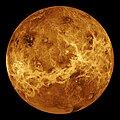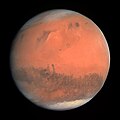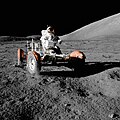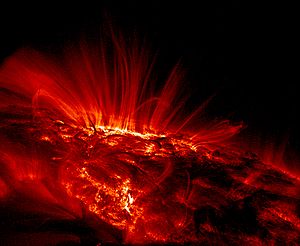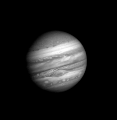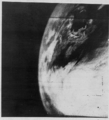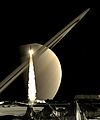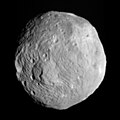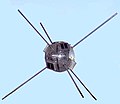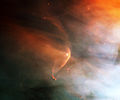Portal:Outer space
Portal maintenance status: (April 2019)
|
Introduction
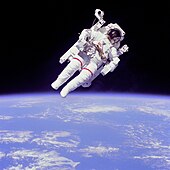
Outer space (or simply space) is the expanse that exists beyond Earth's atmosphere and between celestial bodies. It contains ultra-low levels of particle densities, constituting a near-perfect vacuum of predominantly hydrogen and helium plasma, permeated by electromagnetic radiation, cosmic rays, neutrinos, magnetic fields and dust. The baseline temperature of outer space, as set by the background radiation from the Big Bang, is 2.7 kelvins (−270 °C; −455 °F).
The plasma between galaxies is thought to account for about half of the baryonic (ordinary) matter in the universe, having a number density of less than one hydrogen atom per cubic metre and a kinetic temperature of millions of kelvins. Local concentrations of matter have condensed into stars and galaxies. Intergalactic space takes up most of the volume of the universe, but even galaxies and star systems consist almost entirely of empty space. Most of the remaining mass-energy in the observable universe is made up of an unknown form, dubbed dark matter and dark energy.
Outer space does not begin at a definite altitude above Earth's surface. The Kármán line, an altitude of 100 km (62 mi) above sea level, is conventionally used as the start of outer space in space treaties and for aerospace records keeping. Certain portions of the upper stratosphere and the mesosphere are sometimes referred to as "near space". The framework for international space law was established by the Outer Space Treaty, which entered into force on 10 October 1967. This treaty precludes any claims of national sovereignty and permits all states to freely explore outer space. Despite the drafting of UN resolutions for the peaceful uses of outer space, anti-satellite weapons have been tested in Earth orbit.
The concept that the space between the Earth and the Moon must be a vacuum was first proposed in the 17th century after scientists discovered that air pressure decreased with altitude. The immense scale of outer space was grasped in the 20th century when the distance to the Andromeda galaxy was first measured. Humans began the physical exploration of space later in the same century with the advent of high-altitude balloon flights. This was followed by crewed rocket flights and, then, crewed Earth orbit, first achieved by Yuri Gagarin of the Soviet Union in 1961. The economic cost of putting objects, including humans, into space is very high, limiting human spaceflight to low Earth orbit and the Moon. On the other hand, uncrewed spacecraft have reached all of the known planets in the Solar System. Outer space represents a challenging environment for human exploration because of the hazards of vacuum and radiation. Microgravity has a negative effect on human physiology that causes both muscle atrophy and bone loss. (Full article...)
Selected article
The Sun is the spectral type G2V yellow star at the center of the Solar System. The Earth and many other bodies (including other planets, asteroids, meteoroids, comets and dust) orbit the Sun, which accounts for more than 99% of the Solar System's mass. Different latitudes of the Sun rotate at different rates; a point on the equator takes 25 days, while a point at a pole takes 36 days. The resultant torsion upsets the Sun's very strong magnetic field to create an 11-year solar cycle of activity. Heat and light from the Sun have supported almost all life on Earth. Humans use sunlight to grow crops (see photosynthesis) and power solar cells. The Sun is a ball of plasma with a diameter of 1.392 million km (864,950 mi) and a mass of about 2.0×1030 kg, which is somewhat higher than that of an average star. About 74% of its mass is hydrogen, with 25% helium, and the rest made up of trace quantities of heavier elements. The Sun is about 4.6 billion years old, and is about halfway through its main sequence evolution, during which nuclear fusion reactions in its core fuse hydrogen into helium.
Selected picture
-
Image 1Diagram: Kelvin SongA diagram of Jupiter showing a model of the planet's interior, with a rocky core overlaid by a deep layer of liquid metallic hydrogen and an outer layer predominantly of molecular hydrogen. Jupiter's true interior composition is uncertain. For instance, the core may have shrunk as convection currents of hot liquid metallic hydrogen mixed with the molten core and carried its contents to higher levels in the planetary interior. Furthermore, there is no clear physical boundary between the hydrogen layers—with increasing depth the gas increases smoothly in temperature and density, ultimately becoming liquid.
-
Image 2
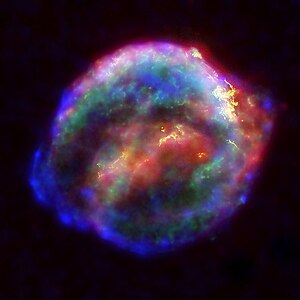
Kepler's Supernova Credit: NASAThis Supernova remnant of Kepler's Supernova (SN 1604) is made up of the materials left behind by the gigantic explosion of a star. There are two possible routes to this end: either a massive star may cease to generate fusion energy in its core, and collapse inward under the force of its own gravity, or a white dwarf star may accumulate material from a companion star until it reaches a critical mass and undergoes a similar collapse. In either case, the resulting supernova explosion expels much or all of the stellar material with great force. -
Image 3The Pioneer plaque, which was included on both Pioneer 10 and Pioneer 11 unmanned spacecraft, the first man-made objects to leave the Solar System. Made from gold-anodised aluminium, the plaque shows the figures of a man and a woman along with several symbols that are designed to provide information about the origin of the spacecraft. However, the mean time for the spacecraft to come within 30 astronomical units of a star is longer than the current age of our galaxy.
-
Image 4Six beryllium mirror segments of the James Webb Space Telescope (JWST) undergoing a series of cryogenic tests at NASA's Marshall Space Flight Center in Huntsville, Alabama. The JWST is a planned space telescope that is a joint collaboration of 20 countries. It will orbit the Sun approximately 1,500,000 km (930,000 mi) beyond the Earth, around the L2 Lagrange point. It is expected to launch in December 2021.
-
Image 5Photo: NASA/Crew of Expedition 22Space Shuttle Endeavour in a photograph taken from the International Space Station, in which the shuttle appears to straddle the stratosphere and mesosphere. During this mission, STS-130, the shuttle's primary payloads were the Tranquility module and the Cupola, a robotic control station which provides a 360-degree view around the station.
-
Image 6NGC 4414 is an unbarred spiral galaxy about 62 million light-years away in the constellation Coma Berenices. It is a flocculent spiral galaxy, with short segments of spiral structure but without the dramatic well-defined spiral arms of a grand design spiral. NGC 4414 is a very isolated galaxy, with no signs of past interactions with other galaxies.
-
Image 7Animation credit: CmgleeThis is an animation showing geocentric satellite orbits, to scale with the Earth, at 3,600 times actual speed. The second-outermost (shown in grey) is a geostationary orbit, 35,786 kilometres (22,236 miles) above Earth's equator and following the direction of Earth's rotation, with an orbital period matching the planet's rotation period (a geosynchronous orbit). An object in such an orbit will appear to occupy a fixed position in the sky. Some 300 kilometres (190 miles) farther away is the graveyard orbit (brown), used for satellites at the end of their operational lives. Nearer to the Earth are the orbits of navigational satellites, such as Galileo (turquoise), BeiDou (beige), GPS (blue) and GLONASS (red), in medium Earth orbits. Much closer to the planet, and within the inner Van Allen belt, are satellites in low Earth orbit, such as the Iridium satellite constellation (purple), the Hubble Space Telescope (green) and the International Space Station (magenta).
-
Image 8

Astronaut Bruce McCandless using a Manned Maneuvering Unit Credit: NASAA Manned Maneuvering Unit (MMU) is a jet pack (propulsion backpack that snaps onto the back of the space suit) which has been used on untethered spacewalks from NASA's Space Shuttle, allowing an astronaut to move independently from the shuttle. The MMU was used on three Shuttle missions in 1984. It was first tested on February 7 during mission STS-41-B by astronauts Bruce McCandless II (seen here) and Robert L. Stewart. -
Image 9
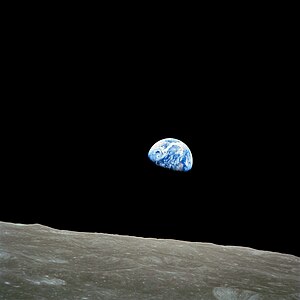
Earthrise, as seen by Apollo 8 Credit: William Anders"Earthrise," the first occasion in which humans saw the Earth seemingly rising above the surface of the Moon, taken during the Apollo 8 mission on December 24, 1968. This view was seen by the crew at the beginning of its fourth orbit around the Moon, although the very first photograph taken was in black-and-white. Note that the Earth is in shadow here. A photo of a fully lit Earth would not be taken until the Apollo 17 mission. -
Image 10Photograph: NASA/JPL-Caltech/University of ArizonaThe Helix Nebula is a large planetary nebula located in the constellation Aquarius. Discovered by Karl Ludwig Harding, probably before 1824, it is one of the closest to Earth of all the bright planetary nebulae, about 215 parsecs (700 light-years) away. It is similar in appearance to the Cat's Eye Nebula and the Ring Nebula.
-
Image 11Image credit: NASAA radar image of the surface of Venus, centered at 180 degrees east longitude. This composite image was created from mapping by the Magellan probe, supplemented by data gathered by the Pioneer orbiter, with simulated hues based on color images recorded by Venera 13 and 14. No probe has been able to survive more than a few hours on Venus's surface, which is completely obscured by clouds, because the atmospheric pressure is some 90 times that of the Earth's, and its surface temperature is around 450 °C (842 °F).
-
Image 12Photograph credit: European Space AgencyMars is the fourth planet from the Sun and is known as the "Red Planet" due to its reddish appearance as seen from Earth. The planet is named after Mars, the Roman god of war. A terrestrial planet, Mars has a thin atmosphere and surface features reminiscent both of the impact craters of the Moon and the volcanoes, valleys, deserts and polar ice caps of the Earth. The planet has the highest mountain in the Solar System, Olympus Mons, as well as the largest canyon, Valles Marineris. Mars's rotation period and seasonal cycles are also similar to those of the Earth. Of all the planets in the Solar System other than Earth, Mars is the most likely to harbour liquid water and perhaps life. There are ongoing investigations assessing Mars's past potential for habitability, as well as the possibility of extant life. Future astrobiology missions are planned, including NASA's Mars 2020 rover and the European Space Agency (ESA)'s Rosalind Franklin rover. In November 2016, NASA reported finding a large amount of underground ice in the Utopia Planitia region of the planet. The volume of water detected has been estimated to be equivalent to the volume of water in Lake Superior. Mars has two moons, Phobos and Deimos, which are small and irregularly shaped.
This picture is a true-colour image of Mars, taken from a distance of about 240,000 kilometres (150,000 mi) by the OSIRIS instrument on ESA's Rosetta spacecraft, during its February 2007 flyby of the planet. The image was generated using OSIRIS's orange (red), green and blue filters. -
Image 13Photo credit: Harrison SchmittAstronaut Eugene Cernan makes a short test drive of the lunar rover (officially, Lunar Roving Vehicle or LRV) during the early part of the first Apollo 17 extravehicular activity. The LRV was only used in the last three Apollo missions, but it performed without any major problems and allowed the astronauts to cover far more ground than in previous missions. All three LRVs were abandoned on the Moon.
-
Image 14Photo credit: Spitzer Space TelescopeThis infrared image shows hundreds of thousands of stars crowded into the swirling core of our spiral Milky Way galaxy. In visible-light pictures, this region cannot be seen at all because cosmic dust lying between Earth and the galactic center blocks our view.
-
Image 15

Planet Mars Credit: NASAMars, the fourth planet from the Sun, is named after the Roman god of war because of its blood red color. Mars has two small, oddly-shaped moons, Phobos and Deimos, named after the sons of the Greek god Ares. At some point in the future Phobos will be broken up by gravitational forces. The atmosphere on Mars is 95% carbon dioxide. In 2003 methane was also discovered in the atmosphere. Since methane is an unstable gas, this indicates that there must be (or have been within the last few hundred years) a source of the gas on the planet. -
Image 16A TRACE image of sunspots on the surface, or photosphere, of the sun from September 2002, is taken in the far ultraviolet on a relatively quiet day for solar activity. However, the image still shows a large sunspot group visible as a bright area near the horizon. Although sunspots are relatively cool regions on the surface of the sun, the bright glowing gas flowing around the sunspots have a temperature of over one million °C (1.8 million °F). The high temperatures are thought to be related to the rapidly changing magnetic field loops that channel solar plasma.
-
Image 17Image credit: Dave JarvisAn illustration of relative astronomical orders of magnitude, starting with the terrestrial planets of the Solar System in image 1 (top left) and ending with the largest known star, VY Canis Majoris, at the bottom right. The biggest celestial body in each image is shown on the left of the next frame.
-
Image 18Pale Blue Dot is the name given to this 1990 photo of Earth taken from Voyager 1 when its vantage point reached the edge of the Solar System, a distance of roughly 3.7 billion miles (6 billion kilometres). Earth can be seen as a blueish-white speck approximately halfway down the brown band to the right. The light band over Earth is an artifact of sunlight scattering in the camera's lens, resulting from the small angle between Earth and the Sun. Carl Sagan came up with the idea of turning the spacecraft around to take a composite image of the Solar System. Six years later, he reflected, "All of human history has happened on that tiny pixel, which is our only home."
-
Image 19Photograph credit: NASA / JPL / Space Science InstituteThe Cassini–Huygens space-research project involved a collaboration between NASA, the European Space Agency, and the Italian Space Agency to send a probe to study the planet Saturn and its system, including its rings and its natural satellites.
This natural-color mosaic image, combining thirty photographs, was taken by the Cassini orbiter over the course of approximately two hours on 23 July 2008 as it panned its wide-angle camera across Saturn and its ring system as the planet approached equinox. Six moons are pictured in the panorama, with the largest, Titan, visible at the bottom left. -
Image 20NASA astronaut Robert Curbeam (left) and European Space Agency (ESA) astronaut Christer Fuglesang participate in STS-116's first of three planned sessions of extra-vehicular activity (EVA) as construction resumes on the International Space Station. The landmasses depicted in the background are the South Island (left) and North Island (right) of New Zealand.
-
Image 21An animated view of Voyager I's approach to Jupiter. One frame of this image was taken each Jupiter day (approximately 10 hours) between January 6 and February 9, 1979, as the space probe flew from 58 million to 31 million kilometers from Jupiter during that time. The small, round, dark spots appearing in some frames are the shadows cast by the moons passing between Jupiter and the Sun, while the small, white flashes around the planet, are the moons themselves.
-
Image 22"The Blue Marble" is a famous photograph of Earth. NASA officially credits the image to the entire Apollo 17 crew — Eugene Cernan, Ronald Evans and Jack Schmitt — all of whom took photographic images during the mission. Apollo 17 passed over Africa during daylight hours and Antarctica is also illuminated. The photograph was taken approximately five hours after the spacecraft's launch, while en route to the Moon. Apollo 17, notably, was the last manned lunar mission; no humans since have been at a range where taking a "whole-Earth" photograph such as "The Blue Marble" would be possible.
Space-related portals
General images
-
Image 1Space Shuttle Endeavour had a major impact on its radiator during STS-118. The entry hole is about 5.5 mm (0.22 in), and the exit hole is twice as large. (from Space debris)
-
Image 2For the first time, the NASA / ESA / Canadian Space Agency / James Webb Space Telescope has observed the chemical signature of carbon-rich dust grains at redshift z ≈ 7, which is roughly equivalent to one billion years after the birth of the Universe, this observation suggests exciting avenues of investigation into both the production of cosmic dust and the earliest stellar populations in our Universe. (from Cosmic dust)
-
Image 3Earth and the Moon as seen from cislunar space on the 2022 Artemis 1 mission (from Outer space)
-
Image 5NASA computer-generated image of debris objects in Earth orbit, c. 2005. (from Space debris)
-
Image 7Model of Vostok spacecraft (from Space exploration)
-
Image 8Artistic image of a rocket lifting from a Saturn moon (from Space exploration)
-
Image 10Astronomers used the James Webb Space Telescope to image the warm dust around a nearby young star, Fomalhaut, in order to study the first asteroid belt ever seen outside of the Solar System in infrared light. (from Cosmic dust)
-
Image 12A MESSENGER image from 18,000 km showing a region about 500 km across (2008) (from Space exploration)
-
Image 13Reconstruction of solar activity over 11,400 years. Period of equally high activity over 8,000 years ago marked. (from Space climate)
-
Image 17The distribution of ionized hydrogen (known by astronomers as H II from old spectroscopic terminology) in the parts of the Galactic interstellar medium visible from the Earth's northern hemisphere as observed with the Wisconsin Hα Mapper (Haffner et al. 2003) harv error: no target: CITEREFHaffnerReynoldsTufteMadsen2003 (help). (from Interstellar medium)
-
Image 18A micrometeoroid left this crater on the surface of Space Shuttle Challenger's front window on STS-7. (from Space debris)
-
Image 19Buzz Aldrin taking a core sample of the Moon during the Apollo 11 mission (from Space exploration)
-
Image 20A computer-generated map of objects orbiting Earth, as of 2005. About 95% are debris, not working artificial satellites (from Outer space)
-
Image 21A dusty trail from the early Solar System to carbonaceous dust today. (from Cosmic dust)
-
Image 22Because of the hazards of a vacuum, astronauts must wear a pressurized space suit while outside their spacecraft.
-
Image 23Timeline of the expansion of the universe, where visible space is represented by the circular sections. At left, a dramatic expansion occurs in the inflationary epoch, and at the center, the expansion accelerates. Neither time nor size are to scale. (from Outer space)
-
Image 25Conventional anti-satellite weapons such as the SM-3 missile remain legal under the law of armed conflict, even though they create hazardous space debris (from Outer space)
-
Image 26Cosmic dust of the Andromeda Galaxy as revealed in infrared light by the Spitzer Space Telescope. (from Cosmic dust)
-
Image 27Space debris identified as WT1190F, burning up in a fireball over Sri Lanka. (from Space debris)
-
Image 28The International Space Station is an orbiting laboratory for space applications and habitability. Visible in the background is yellow-green airglow of Earth's ionosphere and the interstellar field of the Milky Way. (from Outer space)
-
Image 30A laser-guided observation of the Milky Way Galaxy at the Paranal Observatory in Chile in 2010 (from Outline of space science)
-
Image 32Apollo 16 LEM Orion, the Lunar Roving Vehicle and astronaut John Young (1972) (from Space exploration)
-
Image 33Major elements of 200 stratospheric interplanetary dust particles. (from Cosmic dust)
-
Image 34View of an orbital debris hole made in the panel of the Solar Max satellite. (from Space debris)
-
Image 35Objects in Earth orbit including fragmentation debris, November 2020, NASA: ODPO (from Space debris)
-
Image 36Spent upper stage of a Delta II rocket, photographed by the XSS 10 satellite (from Space debris)
-
Image 37Illustration of Earth's atmosphere gradual transition into outer space (from Outer space)
-
Image 40Large-scale matter distribution in a cubic section of the universe. The blue fiber-like structures represent the matter, and the empty regions in between represent the cosmic voids of the intergalactic medium (from Outer space)
-
Image 41Vanguard 1 is expected to remain in orbit for 240 years. (from Space debris)
-
Image 42Apollo Command Service Module in lunar orbit (from Space exploration)
-
Image 43Perseverance's backshell sitting upright on the surface of Jezero Crater (from Space debris)
-
Image 45Cosmic dust of the Horsehead Nebula as revealed by the Hubble Space Telescope. (from Cosmic dust)
-
Image 46The diversity found in the different types and scales of astronomical objects make the field of study increasingly specialized. (from Outline of space science)
-
Image 47Bow shock formed by the magnetosphere of the young star LL Orionis (center) as it collides with the Orion Nebula flow
-
Image 48Voyager 1 is the first artificial object to reach the interstellar medium. (from Interstellar medium)
-
Image 49Debris density in low Earth orbit (from Space debris)
-
Image 50The sparse plasma (blue) and dust (white) in the tail of comet Hale–Bopp are being shaped by pressure from solar radiation and the solar wind, respectively.
-
Image 51A proposed timeline of the origin of space, from physical cosmology (from Outline of space science)
-
Image 53Gabbard diagram of almost 300 pieces of debris from the disintegration of the five-month-old third stage of the Chinese Long March 4 booster on 11 March 2000 (from Space debris)
-
Image 54Concept for a space-based solar power system to beam energy down to Earth (from Outer space)
-
Image 55The original Magdeburg hemispheres (left) used to demonstrate Otto von Guericke's vacuum pump (right)
-
Image 56Concept art for a NASA Vision mission (from Space exploration)
-
Image 57Astronaut Piers Sellers during the third spacewalk of STS-121, a demonstration of orbiter heat shield repair techniques (from Outline of space science)
-
Image 60A computer-generated animation by the European Space Agency representing space debris in low earth orbit at the current rate of growth compared to mitigation measures being taken. (from Space debris)
-
Image 61Astronaut Buzz Aldrin had a personal Communion service when he first arrived on the surface of the Moon. (from Space exploration)
-
Image 62After reentry, Delta 2 second stage pieces were found in South Africa. (from Space debris)
-
Image 63Infographic showing the space debris situation in different kinds of orbits around Earth (from Space debris)
-
Image 64Smooth chondrite interplanetary dust particle. (from Cosmic dust)
-
Image 65Debris impacts on Mir's solar panels degraded their performance. The damage is most noticeable on the panel on the right, which is facing the camera with a high degree of contrast. Extensive damage to the smaller panel below is due to impact with a Progress spacecraft. (from Space debris)
-
Image 66Map showing the Sun located near the edge of the Local Interstellar Cloud and Alpha Centauri about 4 light-years away in the neighboring G-Cloud complex (from Interstellar medium)
-
Image 67A wide field view of outer space as seen from Earth's surface at night. The interplanetary dust cloud is visible as the horizontal band of zodiacal light, including the false dawn (edges) and gegenschein (center), which is visually crossed by the Milky Way (from Outer space)
-
Image 69Known orbit planes of Fengyun-1C debris one month after the weather satellite's disintegration by the Chinese ASAT (from Space debris)
-
Image 71Growth of tracked objects in orbit and related events; efforts to manage outer space global commons have so far not reduced the debris or the growth of objects in orbit (from Space debris)
-
Image 72Artist's impression of dust formation around a supernova explosion. (from Cosmic dust)
-
Image 73Atmospheric attenuation in dB/km as a function of frequency over the EHF band. Peaks in absorption at specific frequencies are a problem, due to atmosphere constituents such as water vapor (H2O) and carbon dioxide (CO2). (from Interstellar medium)
-
Image 74Near-Earth space showing the low-Earth (blue), medium Earth (green), and high Earth (red) orbits. The last extends beyond the radius of geosynchronous orbits (from Outer space)
-
Image 75Spatial density of LEO space debris by altitude, according to 2011 a NASA report to the United Nations Office for Outer Space Affairs (from Space debris)
-
Image 76Illustration of a satellite breaking up into multiple pieces at higher altitudes. (from Space debris)
-
Image 77This light-year-long knot of interstellar gas and dust resembles a caterpillar. (from Interstellar medium)
-
Image 78The Long Duration Exposure Facility (LDEF) is an important source of information on small-particle space debris. (from Space debris)
-
Image 79Spatial density of space debris by altitude according to ESA MASTER-2001, without debris from the Chinese ASAT and 2009 collision events (from Space debris)
Did you know (auto-generated)

- ... that, for the Space 220 Restaurant, Disney reached out to NASA engineers to understand what a space elevator might look like?
- ... that some severe environmental impacts of the invasion of Ukraine can be seen from space?
- ... that the space industry of India has supported the launch of more than 100 domestic satellites and more than 300 foreign satellites?
- ... that Nature's Fynd, producer of microbe-based meat substitutes, is working with NASA to develop a bioreactor for use in space travel?
- ... that Louis W. Roberts was among the highest ranking African-American space program staff at NASA while the Apollo program was underway?
Space news
2024 in space | |||
|---|---|---|---|
| Space probe launches |
| ||
| Impact events | |||
| Selected NEOs | |||
| Discoveries |
| ||
| Comets | |||
Upcoming spaceflight launches
For a full schedule of launches and deep-space rendezvous, see 2024 in spaceflight.
|
Astronomical events
Topics
| Biology |
| |||||
|---|---|---|---|---|---|---|
| Environment | ||||||
| Society | ||||||
| Technology |
| |||||
2020 in space | ||
|---|---|---|
| Space probe launches |
| |
| Impact events | ||
| Selected NEOs |
| |
| Exoplanets |
| |
| Discoveries |
| |
| Comets | ||
| Space exploration |
| |
2019 in space | ||
|---|---|---|
| Space probe launches |
| |
| Impact events |
| |
| Selected NEOs | ||
| Exoplanets |
| |
| Discoveries |
| |
| Comets | ||
| Space exploration |
| |
2018 in space | ||
|---|---|---|
| Space probe launches |
| |
| Impact events | ||
| Selected NEOs | ||
| Exoplanets |
| |
| Discoveries |
| |
| Novae |
| |
| Comets | ||
| Space exploration |
| |
2017 in space | ||
|---|---|---|
| Space probe launches |
| |
| Impact events | ||
| Selected NEOs | ||
| Exoplanets | ||
| Discoveries | ||
| Comets | ||
| Space exploration |
| |
2016 in space | ||
|---|---|---|
| Space probe launches |
| |
| Impact events | ||
| Selected NEOs | ||
| Exoplanets |
| |
| Discoveries |
| |
| Novae | ||
| Comets | ||
| Space exploration | ||
2015 in space | ||||||
|---|---|---|---|---|---|---|
| Space probe launches |
| |||||
| Impact events | ||||||
| Selected NEOs | ||||||
| Exoplanets |
| |||||
| Discoveries |
| |||||
| Comets | ||||||
| Space exploration | ||||||
Categories
Wikimedia
The following Wikimedia Foundation sister projects provide more on this subject:
-
Commons
Free media repository -
Wikibooks
Free textbooks and manuals -
Wikidata
Free knowledge base -
Wikinews
Free-content news -
Wikiquote
Collection of quotations -
Wikisource
Free-content library -
Wikiversity
Free learning tools -
Wiktionary
Dictionary and thesaurus













